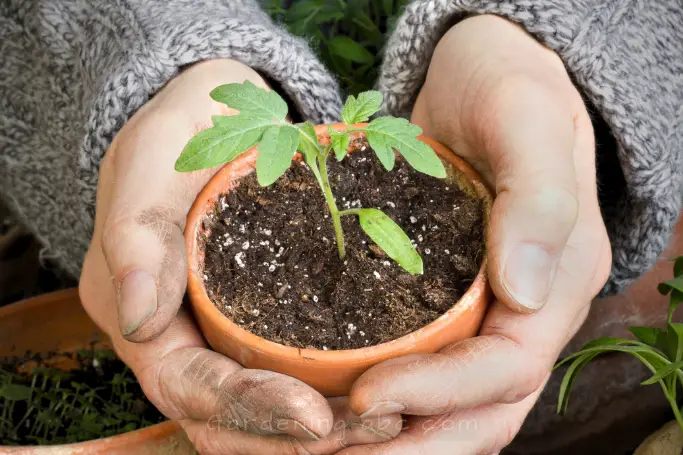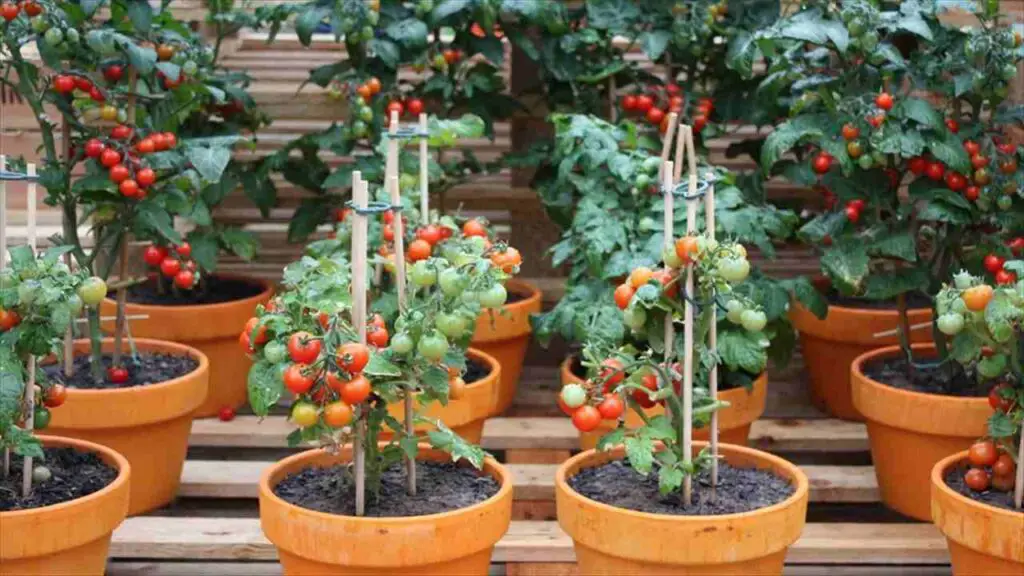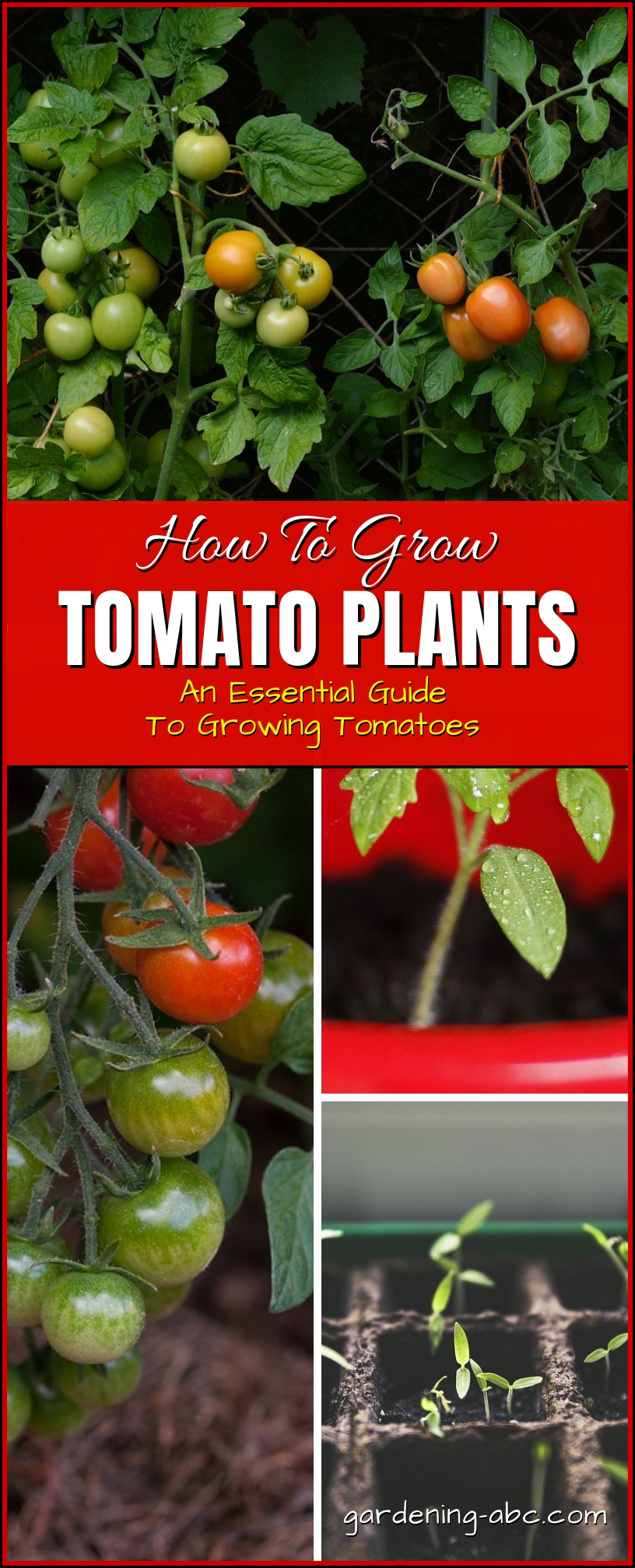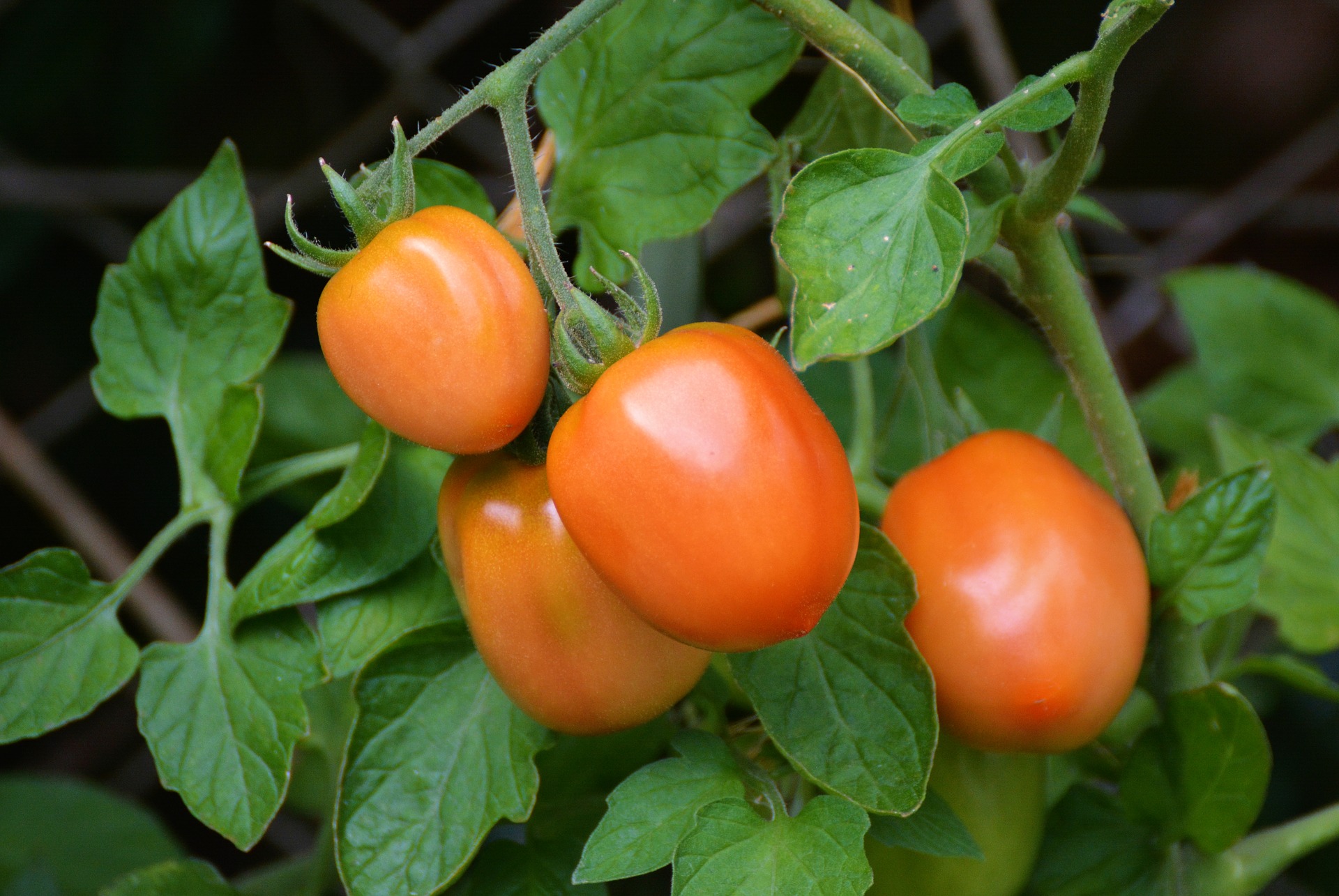We use affiliate links to run our site. When you buy through links on our site, we may earn an affiliate commission, without any added cost to you. Learn more
Can you grow your own tomatoes at home? Absolutely! Even if you’re just starting out, growing tomatoes is fun and super rewarding. They’re really easy to grow, and you’ll pick up the basics fast—even if you’ve never done it before.
This guide’s packed with tips and tricks to help you grow strong, healthy tomato plants so you get loads of tasty, juicy tomatoes. If you’re just getting started, you’ll find this especially helpful.
Alright, let’s jump in!
Growing Tomatoes [In A Nutshell]
| Botanical Name | Solanum lycopersicum |
| Plant Type | Vegetable |
| Sun Exposure | Full Sun |
| Soil pH | Acidic, Slightly Acidic to Neutral |
| Bloom Time | Summer |
| Flower Color | Yellow |
| Growing Season | Tender, warm-season; love sun, can’t bear frost |
| Planting Time | Late spring to early summer in most regions |
| Harvest Time | 60 to more than 100 days depending on variety |
| Growing Methods | Transplants or seeds started indoors |
| Suitable Locations | Full sun, with light afternoon shade |
| Planting Guidelines | Choose reputable young plants, prepare soil |
| Transplanting Time | After all danger of frost and soil is at least 60°F |
| Watering | In early morning, deep watering for strong roots |
| Fertilizing | Organic tomato fertilizer, avoid high nitrogen |
| Support | Stakes, cages, or trellises for vine varieties |
| Recommended Varieties | Determinate and indeterminate types, disease-resistant varieties |
| Tomato Problems | Blossom-end rot, early blight, late blight, mosaic virus, etc. |
| Pests | Tomato fruitworm, tomato hornworm, aphids, etc. |
| Tomato Storage | Never refrigerate fresh tomatoes; can or freeze for long-term storage |
| Nutritional Content | Rich in vitamin C, vitamin A, and iron; low in calories |
| Interesting Facts | Tomatoes originated in America but were initially thought to be poisonous |
Types of Tomato Plants:
There are mainly two types of tomatoes that you can grow in your garden.
- Determinate tomatoes, and
- Indeterminate tomatoes or vining tomatoes
Determinate Type Tomatoes:
People often call these “bush tomatoes.” They stay pretty short—usually topping out around 4 feet—and are perfect for containers.
You don’t have to fuss with stakes or cages, since they’re naturally compact. Plus, they start producing fruit earlier than indeterminate types.
Indeterminate or Vining Tomatoes:
These are the “vining” varieties that just keep growing, sometimes hitting 10 feet tall! You’ll definitely need to give them some support, like a sturdy stake or a big cage.
These plants grow a lot more leaves, and their tomatoes ripen gradually over the whole season. Most heirloom tomatoes fall into this group.
How Long Does It Take to Grow a Tomato?
Tomato plants usually start producing fruit somewhere between 60 and 100 days, depending on the variety. That might sound like a while, but you can speed things up by picking early-ripening types or by starting with young plants (transplants) instead of seeds.
How To Grow Tomato Plants

Light:
Keep your tomato plants in a place where the plants will get plenty of sunlight. The fruit formation of a tomato plant requires at least 6-8 hours of direct sunlight.
Tomatoes usually don’t need any shade all day, but in hot climates, that can be too much to bear and herbs and vegetables appreciate a little shade in the mid to late afternoon.
If you live in a place where the temperature can go really high, give your tomatoes some afternoon shade in summer. This will give the plants some relief.
You can read more about the effect of sunlight on different plants in this article.
Soil:
One of the key elements of growing tomatoes is preparing an ideal soil for the plant. The ideal soil pH for tomatoes is between 5.5 to 6.8 at this level the nutrient intake of the plant is the highest.
So before planting your tomatoes in the soil, use a soil tester like this to make sure that the soil pH is in the right range.
Tomatoes also need a constant supply of nutrients. So start your soil preparation by first tilling the soil and then mixing 3 to 4 inches of homemade compost and manure with the soil. Compost and manures are usually filled with micronutrients as well as NPK.
You can also add used coffee grounds and crushed eggshells to the soil, to give the soil a boost of nitrogen and calcium.
To get a quality yield, it is crucial that you keep the tomato soil fertile. Add a good quality organic fertilizer two weeks prior and two weeks after picking the fruits.
Starting Tomatoes From Seeds:
If you are starting from seeds, we recommend you first plant those seeds indoors, grow seedlings, and then replant them in the ground. The easiest way to raise tomato seedlings is to use trays like these.
Fill these trays with potting soil and sow the seeds 1/2 inch deep in the soil 6 to 8 weeks prior to the average last spring frost date.
Keep the trays indoors until the seeds germinate. Once they have grown up to 15- 20 cm you can transfer them outdoors. But before you plant the seedlings it is crucial that you harden the seedlings so they can withstand the harsh weather outside.
To harden off the seedlings set them outdoors in the shade for a few hours on the first day. Then gradually increase the time each day and add some direct sunlight.
And finally, you can now plant these tomato seedlings on the ground outside.
You can also directly sow tomato seeds in the garden if the soil is at least 55°F. Ideally, you want the soil temperature to be around 70°F as this maximizes the seed germination rate for your tomatoes.
Do not put plants in the ground too early. In most regions, the soil is not warm enough to plant tomatoes outdoors until late spring and early summer except in zone 10. So please keep that in mind.
Buy Tomato Transplant:
Now, another way to grow tomatoes is to start with a transplant. This process is relatively easier and the survival rate is also higher than that of the seeds. You can easily purchase these at a garden center or nursery.
The key here is to choose a healthy and good transplant. Here are the 8 tips on how to choose a good tomato transplant.
Planting the Transplants
Once the seedlings grow their second set of leaves (the first true leaves), the danger of frost is over, and the soil temperature is around 60°F you can transplant your homegrown seedlings or the ones that you bought from the store.
First, you need to create a planting hole so you can plant. You can do it manually or use a hole digger to create a perfect planting hole.
Add a handful of organic tomato fertilizer to the hole before planting the tomato seedlings.
Place the young plants in such a way that the bottom leaves are just above the soil surface. Give a gap of at least 2 to 3 feet between two plants. If it becomes too crowded you won’t get the proper yield.
Water the soil properly.
As a rule of thumb, never plant tomatoes in the same location for at least 3 years.
Growing Tomatoes in Pots:

If you are planning to grow tomatoes in containers choose a large enough pot. Make sure the pot has drainage holes at the bottom.
Use good quality potting soil to fill up the pot. One plant one tomato plant in each pot.
The best varieties for growing in containers are cherry tomatoes and most bush varieties. Although you can choose to grow taller varieties, it will be hard to maintain.
Place the container in a sunny spot so the plant can get at least 6-8 hours of sunlight.
If you live in cooler climates, you can use black plastic pots. They hold heat in and keep roots warm in late spring to early summer. You can also move the pots indoors to protect them overnight and return them to their sunny spot the next day.
Watering:
Tomatoes require plenty of water, especially during the summer. Regularly water the plants, an inch of moisture per week is generally enough, you might need more in the summertime.
Feel the soil; if the top inch is dry, you should water your plants.
But while watering a tomato plant do not wet the leaves or the stem of the plant. Always put water directly into the soil near the roots (see the watering guide for details). Tomato plants grow long roots, so always water deeply.
Fertilizing:
Tomatoes are nutrient-hungry plants. So, it is important you always keep the soil fertile.
Although you have added compost and manure at the time of preparing the soil, you will need to add organic fertilizers during the growing season.
Avoid nitrogen-reach fertilizers, it will only increase the growth of the foliage and inhibit fruit formation. Instead, use an organic fertilizer that is rich in phosphorus and potassium like this one.
Support:
A tomato plant needs support for its growth. You can build a cage or stakes at the time of planting. Staking keeps fruits off the ground whereas a tomato cage helps the plant to hold its upright position.
Pruning:
The easiest way to prune your tomato plants is to simply cut off any leaves that are touching the ground or any branches that have grown onto other branches. Take out any shoot that grows between the stem and main branches, these shoots always hinder the fruit growth.
Also, cutting off the tip of the plant will help the plant to become bushier with much more fruits. You can read more about tomato pruning in this post.
Pest and Diseases:
Tomatoes are particularly susceptible to many pests and diseases. Horn-worms, Aphids, and whiteflies are a few of the tomato pests which can reduce the production of the plant.
Late blight (especially during monsoon), curling leaves, and root rots are some of the most common diseases in the plant.
It is always wise to plant basil along with your tomato plant. Basil is a fantastic companion plant for tomatoes. It will help in distracting little pests from your tomato plant. This type of planting is called companion planting.
Recommended Varieties:

The tastes of tomatoes are very sensitive to the surroundings. So rather than focusing on only one variety, try 3 to 4 varieties and see which suits you and your environment the best.
The followings are the various tomato varieties you can choose from.
Early Variety:
The best thing about the early variety tomatoes is they can mature within 60-70 days. Some of the early varieties of tomatoes are
- Bush Beefsteak,
- Gardener’s Delight,
- Subarctic,
- Early Cascade,
- Early Girl, etc
Midseason Variety:
These varieties of tomatoes will take 70 to 80 days to mature. Some of the popular midseason tomatoes are:
- Abraham Lincoln,
- Beefsteak,
- Big Rainbow,
- Fantastic,
- Floramerica, etc.
Late-season Variety:
These varieties will take 80 days or more to harvest. These are ideal for you if you have a long growing season. Some most popular ones are:
- Brandywine,
- Cherokee Purple,
- Amish Paste,
- Hillbilly, etc
Cherry Tomatoes:
These are a type of small round tomatoes that comes in many colors like red, yellow, green, purple, and black. Some popular cherry tomato varieties are:
- Black Cherry,
- Green Doctors,
- Orange Hat,
- Rosella, etc
Tomatoes can be of several types. Here is a list of all the cultivars from Wikipedia.
How to Harvest Tomatoes:
Never pick tomatoes in the green condition they will rot before get ripe. Leave them on the vine for as long as possible.
Never try to refrigerate ripe tomatoes. It will spoil the texture and taste of the perfectly ripe homegrown tomato. Tomatoes are eaten best sun-warm from the kitchen garden.
Useful Tomato Planting Tips For Growing Great Tomatoes
Growing your own tomatoes is a great way to save money and have access to the freshest produce possible. But it takes a bit of work and patience for the best results. Here are some tomato planting tips for beginners so you’ll get off to a great start with your next tomato plant!
Give Enough Space Among Tomato Seedlings:
When you first start out, one of the mistakes that people make is planting too many tomatoes in a small area.
Plant only one tomato plant per square foot, it is crucial for proper air circulation in roots.
If you were to plant more than that, then your young tomato plants will begin to crowd each other and will not be able to grow as large as they should be able to if they do not receive enough light and airflow around them.
Ensure Lots of Light For Your Tomato Plants:
Tomato plants require at least six hours of direct sunlight each day in order to produce fruit. If your garden doesn’t receive enough sun, consider putting up an artificial light source like this one that mimics sunlight.
You can read more about houselights and growing plants in this post.
Add A Little Airflow:
Turn a fan on your plants for several minutes every day. This will make sure they get enough airflow and will develop strong stems.
Preheat The Garden Soil:
It’s important that the soil is warm before you plant your tomato plants. If you don’t preheat the soil properly, then it could take a lot longer for your plants to acclimate themselves and start producing fruit.
One of the easiest ways to preheat the soil is to cover the area where you want to plant tomatoes with black or red plastic, 15 days prior to planting. This will heat up the soil and result in early tomatoes.
Related post: How to Do Solarization
Plant Deeply:
Bury the stems of tomato plants up to their first leaves when you replant them in the garden. By doing this you can force your tomato plant to develop roots all along its stems.
The more plant you put under the soil, the better the root system. This little trick can make for a stronger plant as well as absorption of more nutrients, and faster growth.
Mulch Your Tomatoes:
Place a 2-inch layer of mulch around each tomato plant. Mulch is simply any organic material used to cover bare soil. In this case, it will help retain moisture in the soil and keep the weeds down.
Straw or newspaper works well, but you can use any other organic material including leaves, grass clippings, or compost.
Trim Off the Bottom Leaves:
Once your tomato plants reach a height of around 3-4 ft remove the bottom leaves of the plant with the help of a pruning shear. These lower leaves are the first few to grow and are more prone to diseases.
Always Prune Your Tomatoes:
Tomato plants need regular trimming for two reasons: to promote growth and to keep them healthy. Pinching or cutting off suckers that appear between the main stem and a branch will stimulate new growth, which will produce more tomatoes.
It’s best to pinch suckers soon after they appear but before they grow larger. But don’t worry if you forget; you can still pinch them later. Just make sure you remove them before they become too large.
Water Regularly:
Tomatoes need a lot of water, especially during the fruiting stage. Make sure they get at least 1 inch of water per week and more during periods of extreme heat. Once the fruits start to ripen up reduce the watering frequency.
Conclusion:
The best-tasting, juiciest tomatoes come from your own garden—hands down. There’s no single right way to grow them—you can plant tomatoes straight in the ground, use containers, raised beds, or even toss them in grow bags. Some folks grow tomatoes hydroponically, too. Just pick the method that fits your space and style.
Hope this helped! These simple tomato tips will make growing your own tomatoes a lot easier. Follow along, and you’ll be chowing down on your favorite homegrown tomatoes with that awesome flavor you just can’t get from store-bought ones.
Thanks for checking this out— Don’t forget to pin it for later!.

Frequently Asked Questions(FAQs):
When’s the best time to start tomato seeds?
Start your tomato seeds indoors about 6-8 weeks before the last frost in your area. That way, they get a good head start before you move them outside.
How often should I water my tomato plants?
Most tomato plants need about 1 to 1.5 inches of water every week. Always soak the soil pretty well and keep the watering regular, but don’t let things get soggy. Adjust how much you water depending on the weather—hot days mean they’ll need more.
What are some common tomato diseases, and how do I keep them away?
Blight, wilts, and leaf spots often trouble tomatoes. You can help prevent these by giving your plants lots of space for air flow, watering at the base (not over the leaves), rotating your crops each year, and picking disease-resistant varieties.
How can I support tomato plants as they grow?
Tomatoes get heavy, so help them out. Use stakes, cages, or even trellises to keep them from sprawling all over. Just set a stake in next to the main stem or put a cage around the plant early on.
When should I start fertilizing my tomato plants?
Start feeding your tomatoes once their first real leaves show up. Use a balanced fertilizer or one made just for tomatoes, and follow the directions on the label.
How do I know when my tomatoes are ready to pick?
Tomatoes are ready to harvest when they’re fully colored (depends on the variety) and feel firm but have a little give when you gently squeeze them. Picking them a tad early can help avoid any damage.
Should I prune my tomato plants?
Pruning can help with airflow and fighting off disease. Snap off the little suckers that pop up between the main stem and the branches so the plant focuses on making fruit.
How can I protect my tomato plants from bugs?
To fend off pests like aphids, caterpillars, or hornworms, try planting marigolds or basil alongside your tomatoes, inviting good bugs to help out, or using natural pest controls.
Can I grow tomatoes in containers?
Totally! Tomatoes do great in pots. Just use a big container with good drainage, fill it with quality potting mix, and make sure you give the plant some support. Keeping up with watering and feeding is extra important in containers.
How do I save seeds from my tomatoes for next year?
Pick some ripe, healthy tomatoes, scoop out their seeds, and let the seeds sit in water for a few days to ferment. Rinse and dry them, then stash them away in a cool, dry spot until it’s time to plant again.
Amazon and the Amazon logo are trademarks of Amazon.com, Inc, or its affiliates.

Trying using Epson salt around the soil of the tomatoes. The Epson salt neutralizes the soil, and makes the tomatoes more sweeter.
"Growing vegetables successfully with your children" on Amazon-Kindle. Its free on Kindle-Prime.
I like tomatoes that taste more acid – like Rutgers. How do you make tomatoes taste more acid???
hi, what is a good time to start these plants in the delhi weather. Tx.
Not sure where you are growing, but this is very poor advice for growing tomatoes in Florida. This much direct sunlight will burn the plants and produce dead plants. In my experience, anything more than about 4ish hours of direct sunlight produces suboptimal results. At that point though, you can grow all year long here.
I like browsing your web sites. With thanks! http://Whitebunkbeds.company/